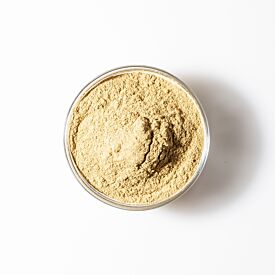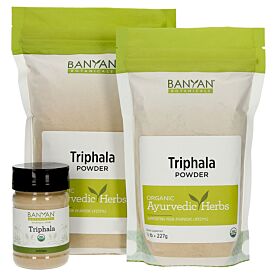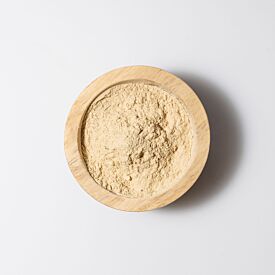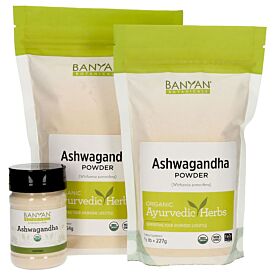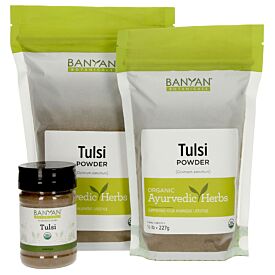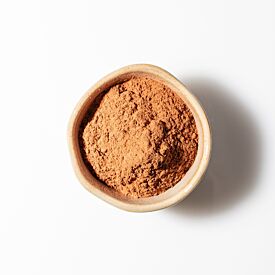An Ayurvedic Approach to a Healthy Cycle

There is certainly no shortage of information or education on health—how to take care of your teeth, how to eat well and take care of your heart and bones, how to keep your gut healthy—but how do you take care of your womb, what does that mean and why is it even important?
Ayurveda is one of the few sciences that looks at the reproductive tissues outside of the major transitions of puberty, pregnancy, and menopause. Further, Ayurveda uniquely exams the menstrual cycle as a window into the human body. By being familiar and in tune with your menstrual cycle, you can understand very clearly, on a month-to-month basis, which dosha imbalances your body is struggling with.
The menstrual flow is a byproduct, after all, of the most basic tissues of the body. After we ingest our breakfast, this food undergoes transformation through the seven tissue layers of the body. The first is plasma, then blood, which is then followed by the muscle and fat tissues. After these four layers comes the bony tissue, nervous system, and, lastly, the reproductive tissues.
The actual menstrual flow is considered to be a byproduct of the first layer, rasa dhatu, or the plasma. Plasma is a vehicle for nourishment. It carries hormones, vitamins, minerals, water—all sources of nourishment. When this layer is healthy and flows freely, so too do all of these nutrients as well as wastes so that they may leave the body with ease. The second layer, rakta dhatu, or the layer of blood, also is part of the menstrual flow, releasing excess pitta.
The rasa dhatu and rakta dhatu are also the first two to be vitiated by excess vata, pitta, or kapha after they leave their home in the gastrointestinal tract. As such, they are most quick to change in quality and consistency. By paying attention to your flow, its qualities, and your experiences before and after its release, you can get a strong sense of how the doshas are at play even before they fully come to fruition on a gross level in other layers of the body.
This gives an opportunity for intervention so that the physiology of the body may come back to a stronger balance, and therefore, stronger health.
The Cycle
The menstrual cycle is thought to go with the ebbs and waves of the lunar cycle, as the moon represents flow, the feminine. The lunar cycle is approximately 29.5 days, coinciding with the average length of the menstrual cycle for most ovulating women. The healthiest flow, one that is most in tune with the lunar phases, will start on a new moon with ovulation occurring around the time of the full moon. When the moon is full, it is at its peak energy, pulling the egg from its home in the ovary.
The doshas also come to play and each dosha will show its face and have the most impact in specific parts of the cycle.
- Kapha dominates the first half of the cycle, called rutukala, after menstruation, as the endometrium thickens and becomes more and more glandular.1 A woman gains the essence of kapha—the juiciness, the glow, the sense of peace and being settled within herself. Rutukāla culminates in ovulation.2
- Ovulation marks the beginning of the next phase, rutāvatēta kāla, dominated by pitta.2 Pitta mainly acts through the blood tissue layer, and as such, the endometrium becomes more engorged with blood vessels,1 in preparation for the potentially fertilized egg.
- If the egg is not fertilized, the last phase, rajahkāla, arrives.2 Sushruta, the legendary ancient Ayurvedic physician and surgeon, has eloquently described this process as “the weeping cry of the vagina for the deceased ovum.” 3 It is a sudden rise in vata that begins the menstrual period, and it acts as a moving force, enabling the flow of menstruation.
As long as the doshas function optimally and aren’t depleted or overshadowed by another dosha, the menstrual cycle functions optimally.
A Closer Look at Rajahkãla
If we were to zoom in on rajahkāla, we will see many things at play. Even the age at which we begin menstruation is telling of dominant doshas in our being. For instance, while menarche occurs on average around the age of fourteen, those with strong pitta in their constitution can begin menstruating as early as nine years old. This is consistent with findings that females in a more pitta dominant, urban society enter into menarche earlier than those in a rural society.4
On the other hand, kapha tends to slow things down and stabilize what exists, such that menarche can occur as late as sixteen years of age.5 Without the kapha, there would not be enough tissues for menstruation, and without sufficient pitta and rasa and rakta, the flow would be weak.
In the female reproductive tissue, vata acts through blood vessels, helping flow go down and out.2 Vata has a multitude of directional flows, and without a fine balance, the downward flow of menstruation can be compromised by strong, upward functions in the body. Apana vayu, which governs downward flow, particularly in the pelvis, is the vehicle for the continuous and easy outlet of wastes, such as feces and urine, in addition to menstruation.
Without groundedness of this vata subtype, many imbalances happen in the pelvis, creating a variety of disorders. Generally, it is the upward flow of energy caused by activities, like too much speaking, thinking, laughing, and running, that pull apana up out of its normal directional flow.
If all of these pieces play their part, harmoniously and synergistically, we get a healthy flow. According to the classics, a healthy menstrual flow has the following characteristics:
- Bright red in color.
- Does not stain clothing (a common characteristic of ama, or toxic, unprocessed substance in our body that clogs channels and creates dysfunction).
- Has an odor that is not foul.
- Has an amount that is on average, four anjalees. A single anjalee is the amount of liquid that would fit into one of your cupped hands. Hence, there is no set amount; it depends on the person, their constitution, and their size.5
Doshic Differences in Menstruation and Management

Vata Menstrual Flow
Characteristics of a Vata-Vitiated Flow
As vata percolates through the blood vessels and into the uterus, its cold qualities along with dry and rough bring a sense of tightening. Blood vessels constrict. Dryness depletes all bodily tissues and can eventually lead to emaciation, which is a known cause of the cessation of menstrual flow. The process begins with a decrease in the plasma and blood tissues, decreasing nourishment to and thinning out the lining of the uterus, thereby decreasing overall flow and discharge of the menstrual flow.
And, as a general rule, wherever there is discomfort, there is some form of vitiation or blockage of the free flow of vata. So it happens that most vata-vitiated cycles are accompanied by discomfort. As the flow of blood is slowed and even obstructed, fresh blood is mixed in with some old blood as it exits the system, giving a darkened color of the menstrual flow.
As you think about the qualities of vata (light, mobile, cold, dry, rough, subtle, clear), the types of vata menstrual qualities become obvious. Also, think about the home of vata—the pelvis and thighs—because the imbalances will often arise in those areas.
| Discomfort | Prickling, sharp, spasmodic, often in lower abdomen or back |
| Emotions | Anxiety, nervousness, fear |
| Menstruation | Frothy, thin, dry (absence of mucous), dark in color, lightening of the flow |
| Other potential imbalances | Stiffness, sensation of creeping ants5 |
Balancing the Vata Flow
When balancing the menstrual cycle, treat with the opposite qualities. Thus, for a vata menstrual cycle, draw in qualities of heaviness, warmth, stability, oiliness, and liquid. Welcoming the elements of earth and water will prove to be very nourishing and grounding, as they have those same qualities.
- Vata-pacifying diet and lifestyle. Start with the basics. Eat warm, mushy foods cooked in warm spices and plenty of ghee, especially if your menstrual cycle seems to be decreasing in flow or appears to be more dry.6, 7 Above all, avoid caffeine. Slow down and bring awareness to every moment.
- Castor Oil Packs. Castor oil has the qualities of being oily, heavy, sticky, sharp, penetrating and is heating internally.8 Castor oil will not only nourish and ground apana vayu and the tissues, but also can break stagnation and blockages caused by dried up vata, as in the case of constipation.9 This should not be done while you are menstruating.
- Hydration. Hydrate the body. Dry and scanty vata cycles are usually due to a depletion of the nourishing rasa dhatu. Drink plenty of water. Also accompany water with healthy oils, such as ghee, flaxseed oil, and hempseed oil, which will help bring more moisture to your tissues.
- Pranayama and Yoga. Focus on yoga poses for the vata individual when not on the menstrual cycle. Pranayama that will pacify the lightness and erratic nature of vata are anuloma viloma, bhramari andutgeet.10
Herbs can be very supportive to the vata menstrual cycle. Healthy Vata and Vata Digest can pacify systemic vata. Combining a formulation like Vata Digest with nourishing herbs, like Shatavari and Ashwagandha, helps digest these powerful herbs, unlocking their nourishing and building actions. These herbs are available individually in tablet form or in a complete formula with other vata pacifying herbs, Healthy Vata. A hot Dashamula tea twice daily can bring stability and strength to a vata vitiated system. Fresh ginger tea can also be very helpful in menses accompanied by discomfort.11,12,13 Please consult with an Ayurvedic practitioner for specialized guidance.

Pitta Menstrual Flow
Characteristics of a Pitta-Vitiated Flow
Pitta is characteristically hot and sharp. It brings heat and fluidity and a spreading nature to the blood, such that it flows with ease—sometimes too much ease. Pitta loves to reside in the blood, and in excess, it will seek to be released through this avenue. Hence pitta menstrual cycles are often heavy. With the heat so too comes irritation in the body, which can provoke swelling. Such is the case with tender, swollen breasts that many women will experience during the premenstrual period.
| Discomfort | Burning sensation |
| Emotions | Anger, irritability |
| Menstruation | Yellow or red, hot, profuse, fleshy smelling or foul smelling, heavier flow |
| Other potential imbalances | Excess swelling in the body, increased body temperature, headache, tender breast, acne, nausea, vomiting, diarrhea5 |
Balancing the Pitta Flow
To effectively bring balance to the pitta flow, there must be a counterbalance of the hot quality with coolness and the sharp quality with dullness and softness.
- Pitta-pacifying diet and lifestyle. Bring calmness and softness to life, without the ambition, competition, and anger that is so common with our pitta dominated society. Avoid spicy and oily foods. Be careful, however, not to aggravate vata in the process.
- Nasya. For pitta-type premenstrual imbalances that often lodge in the head, such as headaches, try Nasya. The practice of nasya has a balancing affect to the energy in the head. Avoid this practice while menstruating.
- Coconut oil pack. This is done just as one would with the castor oil pack, except replace the castor oil with cooling, coconut oil. Coconut oil is especially balancing to pitta because of its cooling quality and sweet taste.8 You can do this pack daily when you are not menstruating.
- Breast massage. For those who suffer from tender breasts during the premenstrual period, breast massage can be helpful.14 Try Breast Care Balm, a balm specially formulated to help promote the movement of lymph. Massage thoroughly, as often as daily, during the premenstrual period and until the discomfort subsides.
- Pranayama and Yoga. Follow a pitta-friendly yoga practice. Sheetali and sheetkari pranayamas are ideal for bringing coolness to the pitta individual.10
The pitta flow is an area where herbs can really be of assistance. In the Ayurvedic tradition, cleansing the blood is the best and most permanent way to release pitta. Blood Cleanse contains herbs that will balance the blood and help rid it of toxins. For additional cleansing, donate blood at your local blood bank. Aloe vera juice or gel, consumed twice daily, not only cools and cleanses the blood of pitta, but it also has a strong affinity to the female system.17 Ashoka tones the uterus and thus eases a heavier flow.15 Women’s Support, is a wonderful formula for the female reproductive system, in general, and is designed to remove pitta from the system, as it contains shatavari, guduchi, aloe vera, and gotu kola, amongst other supportive herbs. Please consult with an Ayurvedic practitioner for specialized guidance.

Kapha Menstrual Flow
Characteristics of a Kapha-Vitiated Flow
Stagnation, arising from its denseness, heaviness, dullness, stickiness, and coolness, poses difficulty to those with a kapha imbalance. As stagnation grows, obstruction and blockages of the system occur, particularly in the rasa dhatu at first, as this is a very comfortable home for kapha. This gives rise to the sensation of bloating, puffiness, and swelling that so many dread during their premenstrual and menstrual periods. Further, the stronger the blockage, the more the tissue is likely to go into a mode of overgrowth. As more blood vessels grow to supply this growth, the kapha cycle is more likely to experience a heavier flow than the vata cycle.
| Discomfort | Dull discomfort and itching |
| Emotions | Depression, emotional eating |
| Menstruation | Yellowish, mucoid, unctuous, a heavier, yet longer, flow |
| Other potential imbalances | Swelling, water retention, bloating, leucorrhea, yeast infections, increased sleep5 |
Balancing the Kapha Flow
Kapha brings heaviness, thickness, oiliness, dullness, and slowness into rasa dhatu, which goes directly to the female system. By inviting lightness, thinness, and more fluidity, much of the stagnation in the system can be relieved. To accomplish this, stimulate agni, the metabolic and transformative fire within us. The warmth of agni will counteract all of the qualities of kapha and melt it to its healthy state.
- Kapha-pacifying diet and lifestyle. Throughout the day, keep warm and dry. Stimulate agni with spices such as ginger, cinnamon, cardamom, and black pepper. Wake up early with the sun and avoid daytime napping. Stay active!
- Exercise. Walk daily. By exercising, we are stimulating the movement of blood and lymph throughout the body. Be mindful, however, to keep calm and rested during the menstrual cycle.
- Castor oil pack. With castor oil’s warm and penetrating qualities, we can really break up quite a bit of stagnation latent in the pelvis. Don’t be alarmed if your first flow is heavier than normal. This is a sign of blockage release, and generally subsides after the first cycle or two. Again, remember that this practice should not be done while menstruating.
- Salt scrub. Add a salt scrub to your daily self-massage. The addition of salt increases roughness and friction, bringing movement and heat to the skin. The friction also penetrates deeper to help lymph move.
- Pranayama and yoga. In addition to a kapha yoga program, pranayama is greatly beneficial because it facilitates the proper movement of prana. Releasing stagnation in this subtle layer can have profound effects on the more gross, physical layer. Further, pranayama, especially bhastrika and kapalabhati, directly activate muscles that massage the lower abdomen and pelvis. By increasing agni, bhastrika and kapalabati bring warmth and help relieve stagnation.10
Herbs that help reduce swelling and excess water in the body, while keeping the waters of the body flowing, will greatly benefit the kapha flow. Ginger and tulsi tea have a great affinity to this tissue layer and nourish it through their warming and building qualities. Healthy Kapha is a perfect combination of herbs to move excess kapha. If you have excess tissue in the reproductive tract, combine these herbs with Kanchanar Guggulu, which may be a good choice as it is a combination of herbs that breaks down deep-seated kapha.

General Menstrual Self-Care
The menstrual cycle is effectively a monthly cleanse and is treated as such in the Ayurvedic tradition. Our goal, then, is to support the process of cleansing. As with any other cleanse, importance is placed on rest and rejuvenation, and kindling agni. For this reason, for centuries, women in India have been given the opportunity to be relieved from their daily duties and go in seclusion so that their bodies may fully cleanse both on the physical and mental levels. The menstrual cycle is a gift and can be viewed as such, instead of being viewed as a nuisance or inconvenience.
Basic Guidelines for a Healthy Menstrual Cleanse
- Eat a simple diet. You want to reserve all of your body’s digestive fire for the purpose of cleansing. Eating kitchari and other warm, thoroughly cooked meals will do just that. Try adding spices, such as ginger, cardamom, saffron, cumin, coriander, fennel, and cinnamon.
- Honor yourself with rest and rejuvenation. Cleansing involves the movement of wastes down and out of the body and we want to be sure that that directional flow is not counteracted by upward movements, like excessive talking or thinking, sexual intercourse, and even pranayama and yoga. These activities also take up a lot of energy and your body needs to use all of its reserve energy towards cleansing.
- Don’t suppress urges, like urination, defecation, and sneezing. Doing so promotes vata to go opposite of its normal downward flow.16
- Reflect and Meditate.
- Hydrate. As with any other cleanse, hydration is of utmost importance to move wastes. During a menstrual cleanse, hydrate with warm teas, such as ginger tea, lemon tea with honey, or CCF tea (cumin, coriander, and fennel).8

Maintaining balance when you are not menstruating is of equal importance. Below are some tips to keep the flow of vata grounded and prevent stagnation or vitiation within the plasma and blood tissues of the body. The key is to keep the doshas in check.
- Cleansing. There is no better way to balance the doshas than to do a yearly cleanse. Seasonal cleansing is a highly effective way to balance and rejuvenate all bodily tissues so that they function optimally.
-
Daily Routine. A daily routine keeps the body in rhythm and moving on schedule. The regularity of a daily routine is grounding because your body begins to perceive you and the world as reliable and dependable. Try to incorporate the following into your routine, and do these activities as per your constitution, such that it does not cause further vitiation of doshas.
- Self-massage.
- Exercise.
- Eat at a consistent time.
- Pranayama. Nadi Shodhana is heralded for balancing in the mind, as it seeks to equalize the left and right side of the brain.10 As this balance is gained, the neurochemistry of the brain, including hormones, normalize. The ideal for this purpose is to do twenty minutes before sleep. Continue the pranayamas discussed previously as per your doshic menstrual flow.
- Yoga. A strong yoga practice as per your dosha will keep your body strong and limber, removing physical blockages for pranic flow. Poses particularly great for the female reproductive system are Child’s Pose (Balasana), Butterfly’s Pose (Baddha Konasana), Bridge Pose (Setu Bandhasana), Plow (Halasana) and reclining Hero (Supta Virasana).10
Herbal Support
The formulations mentioned in each doshic menstrual type are beautifully catered for that dosha. The herbs mentioned with them are also very helpful to target a specific menstrual flow. In addition to those, the following herbs can aid in meeting your particular needs.
- Ashoka. Ashoka is the queen of herbs for the female reproductive system, as a uterine tonic and aiding in heavy bleeding and discomfort.15 Literally meaning, “remover of sorrow,” this herb will aid in physical as well as psychological pain.17 Its astringent taste also aids in removing excess tissue and wastes and helps tone the uterus, aiding in heavy cycles.18
- Shatavari. Shatavari has been translated as the “woman who has a hundred husbands.” This herb is very building, is pitta reducing, and has a particular affinity to the female reproductive tract and urinary system.17 As such, it is seen as an adaptogen during times of stress and over-taxation of the body.19
- Ashwagandha. While ashwagandha is more known for its benefits in men, it is also used traditionally as a great tonic and adaptogen for the nervous system, including the adrenals.17, 20, 21 This, along with its building properties, make it a go-to herb for emaciation and burn-out, which can cause a scanty, vata flow.
- Kanchanar guggulu. This guggulu formula contains heating and cleansing herbs in addition to kanchanar.18 It is great for scraping and moving out wastes, particularly in gynecologic imbalances involving stagnation and congestion.17
- Anantamul. The Ayurvedic classic texts love anantamul as a pitta pacifier in the blood, making it a great blood cleanser, and in the genitourinary tract.22 It acts as a cleanser, in addition to being a nourisher.17
- Aloe vera. In Sanskrit, this herb is called kumari, meaning “young maiden.” Aloe vera is widely respected as being highly supportive of a woman’s reproductive system. In such a way, the classic Ayurvedic texts have referred to this herb repeatedly for gynecological disturbances.17 Aloe is cooling and very cleansing to the urine, blood, and plasma.23 It removes stagnation and blockages and acts as a tonic.18, 24 It is often used in conjunction with other herbs as a vehicle, or anupan, to the reproductive system.17 (For information on more of these Ayurvedic carrier substances, see our anupan guide.) Aloe vera can be found in Women’s Support tablets.
- Manjistha. Foremost, manjistha is an excellent blood cleanser, removing pitta, while also building the blood gently. As it cleanses the blood, it also is able to remove stagnation and constriction within the reproductive tract.18 Manjistha is one of the main ingredients in Blood Cleanse tablets.
- Triphala. Triphala is most known for its ability to aid in the elimination of wastes, particularly from the gastrointestinal tract, and removing toxins from the body. In addition, it is a great rejuvenative.25
- Tulsi. Tulsi is not only warming and nourishing to the lungs and prana, but it is a builder and nourisher of the rasa dhatu, making it a beautiful herb for nourishment for flow.17
Here’s to a Healthy Flow
So many women suffer from menstrual imbalances, leaning on a limited number of tools. And given that it is such a huge part of our life, coming monthly, it can be frustrating, burdensome, and even debilitating. Not only does Ayurveda provide alternative solutions that really work at the root level, but it also gives the opportunity to reshift our chemistry before more difficult conditions arise by being able to use our menstrual cycle as a barometer of what lies within us. Ayurveda also blesses us with the outlook that this is ultimately a cleanse. And by viewing it as such, we can work with our body towards greater health, instead of running against its natural work.
We hope that we have equipped you with a few more tools to help you on your way towards balance and health. The female body is truly unique and beautiful. Use it towards great health as a roadmap, paying attention to all of the signs and subtlest shifts. You will learn more about yourself that goes beyond just the physical.



